Ryse: Son of Rome is what I want from a next-gen game. It’s something different. And it’s something impressive. Ryse is also a game I expected to not like very much, so let’s give it one more label: a pleasant surprise on day one for Xbox One.
Seven years in the making by a collection of studios under the Crytek umbrella, Ryse is the adventure of one Marius Titus, a Roman soldier who has both the will to defend his people and the skill to chop off his enemies’ arms.
Marius is the star of a very brutal game… a game of combat, a game of killing, a game that was recently and notoriously likened to being as much fun as dialling phone numbers, a game supposedly full of quick-time events, a game that used to be for Kinect, a game from the people who usually bring you first-person shooters and not third-person melee games, a game that…yes, I thought Ryse was going to suck.
So what have we got here?
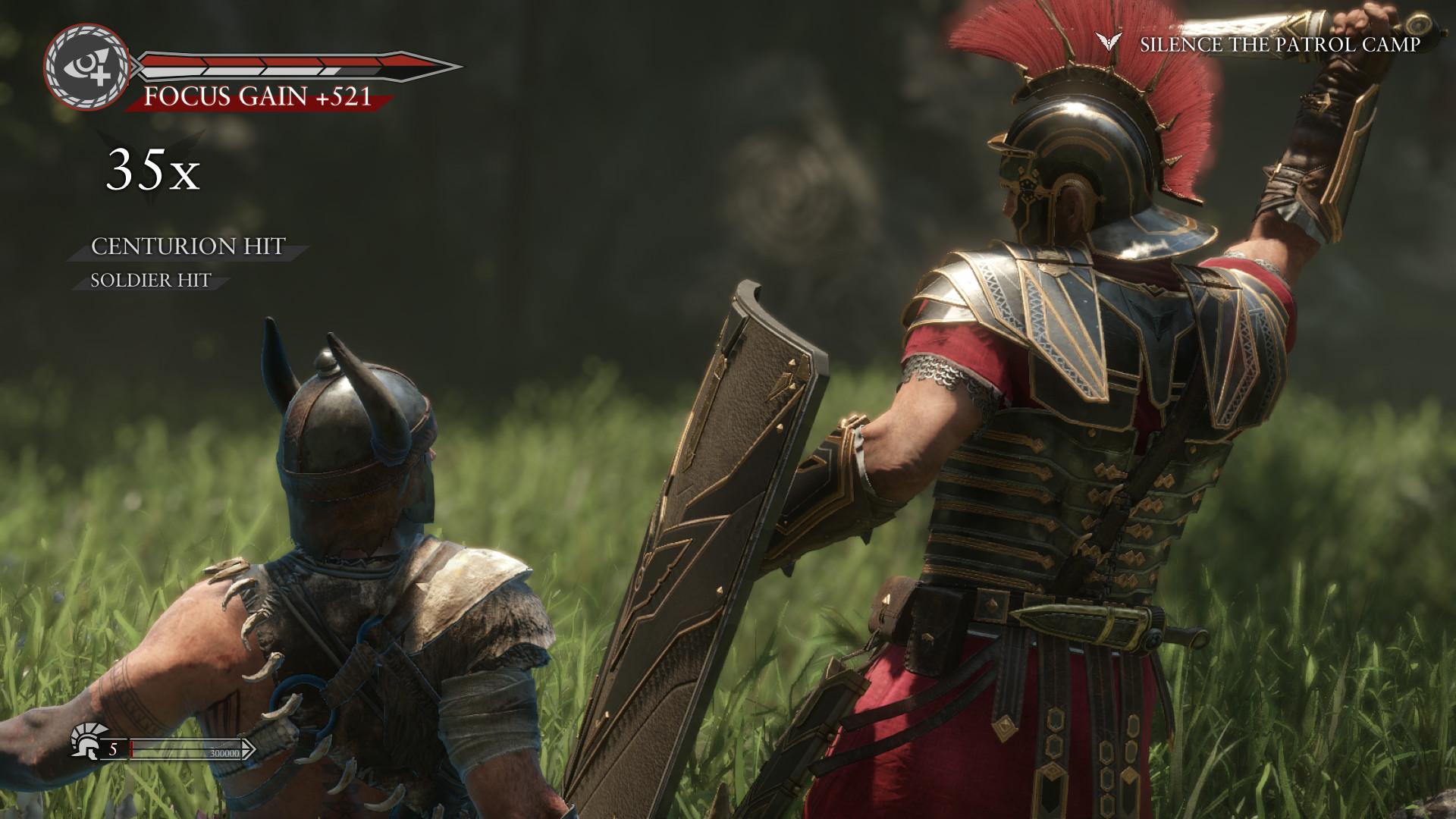
We’ve got a head-turning beauty of bloody historical fiction set at the time of Nero nearly two millennia ago. This is a third-person action game, though it doesn’t look that much like action games I’ve played before. We don’t play many games set in this era nor have we gamers had many chances to line up with centurions against barbarians in ancient Rome or charge the shores of Roman-occupied Britannia.
We also don’t play many games where the camera is in this tight. The characters are often massive in Ryse, as if the designers wanted to impress you with the Xbox One’s graphics by making it seem like you’re closer to them. “Here, look at this!” Ryse says as it grabs you by the collar and moves your face to the TV.
Some games show off graphics just to, well, show off. Rarely can you point to great graphics and say that they improve the gameplay, but in Ryse, they do. They help distinguish Ryse from being just another brawler. They excuse, to some extent, the game’s constricting linearity and invisible walls. They aid Ryse’s gameplay by supporting a melee combat system that works best if you, the player, visually “reads” your character’s movements.
See, Ryse risks being an awful game by introducing the oddity of combat sequences that are impossible to fail. The game allows the player to activate optionally-interactive finishing sequences, dubbed as “executions,” that will work play out and kill an enemy even if you do nothing. What could be a travesty, however, turns out to be something novel and enjoyable: a combat system that switches from manual to automated and that, when it switches, rewards players who read the graphics well. It empowers the player who can anticipate their character’s next moves based on his complicated animations and who can do this with such finesse that they can rack up scores, chain combos, purchase more extravagant moves and, all the while, infuse their character with better and better stat boosts.
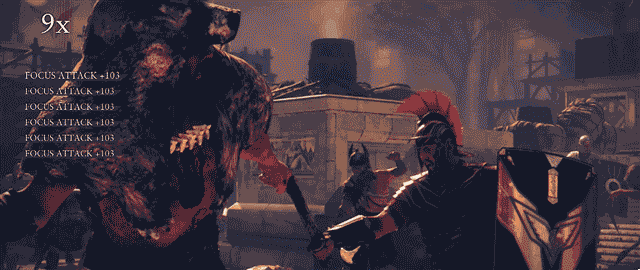
Sure, you could just sit back and let Ryse play itself half of the time, or you could get involved with the gameplay and play it like a combo-driven action game, one that assumes you can follow the flow of the action.
I admit that this is an odd way to present combat in a game, but it drew me in almost immediately. As each encounter in the game begins, you’ll feel like you’re playing a standard third-person action game. You’re a skilled fighter surrounded by two, three, four or more enemies. In this variation, you’re a Roman soldier with a sword and shield, hacking and bashing, pushing metal through bone. Your enemies will take turns attacking, as they tend to in action games. You’ll strike or push, heavy strike or heavy push, block or roll. As you dent their defences, you’ll get a signal that you can start an execution.
Trigger an execution and the enemy is dead meat. It’s guaranteed. You will be able to play out whichever grisly one the game cues up for you, pulling from a pool of dozens of executions you’ve unlocked. At these moments, your inputs are reduced to pushing the Xbox One controller’s yellow Y button or the blue X. Or you could do nothing. Ideally, you’ll do something! But the kill will happen anyway.
The impossibility of failure and the simplicity of commands during these executions should ruin things. It should earn the game scorn. Yet this is where Ryse‘s graphics and animations save it and elevate the combat system. As Marius begins his execution sequence, he might first swing his shield at his enemy’s head, then stab him in the chest and then pull that sword out. That’ll be a Y-X-X combo. You won’t trigger it. You won’t even dial up that combo. You’re really just reacting to prompts. The bad way of doing that is to wait and wonder whether Marius’ enemy will suddenly be highlighted blue or yellow and then react to that. The better way to do this is to appreciate the graphics and actually watch Marius’ movements. If he is about to use his sword hand, be ready to press X. If he is about to use any other part of his body to attack, use Y. This might not seem like a big difference, but it is. It feels special, because because the tells that the player is reading aren’t those of his enemy’s but those of the exceptionally well-rendered main character. (OK, I just said ‘it feels special’ about some of the most realistically depicted ultraviolence I’ve ever seen in a game. The violence in this game can get a bit weird. More on that in a bit.)
During the executions, the player’s challenge is to watch Marius’ arm and leg movements and understand them, to essentially anticipate them. This is a different way to relate to a game character and one that works well. It works because of the reward. If you wait for the colour prompts before figuring out which button to press, you’re playing a guessing game or a reflex text. You’re reacting to known information rather than reading movement and essentially moving with the game. If you just wait for the colour prompts you’re also likely to be slower and to merely pull off a “recruit” or “soldier”-level execution. These are worth little. If you instead focus on reading Marius’ movements, you’ll consistently be able to pull off “centurion” or even “legendary” executions. Those superior execution ratings greatly raise your combo meter and earn you more points in whichever of four categories of execution Marius has performed. He can, to be clear, do executions that earn him health points, focus points, damage points or experience points, all of which are useful and all of which can be triggered on the fly before or even during a killing sequence.
All of this execution stuff works well thanks to the absurd number of executions programmed into the game. Marius can unlock some 98 ways to execute his enemies, 42 of which are reserved for when the player weakens two enemies and tries to execute both in one sequence. That amount of variety makes it harder to predict which execution Marius will do next, keeping the player guessing and forcing them to, as noted, focus on their character’s movements.
The better you do in combat, the more points you earn, the more executions you unlock, the more of Marius’ skills you increase, the better you can do in combat. The progression is simple and keeps combat engaging even when the game is sending a few too many of the same enemies at you.
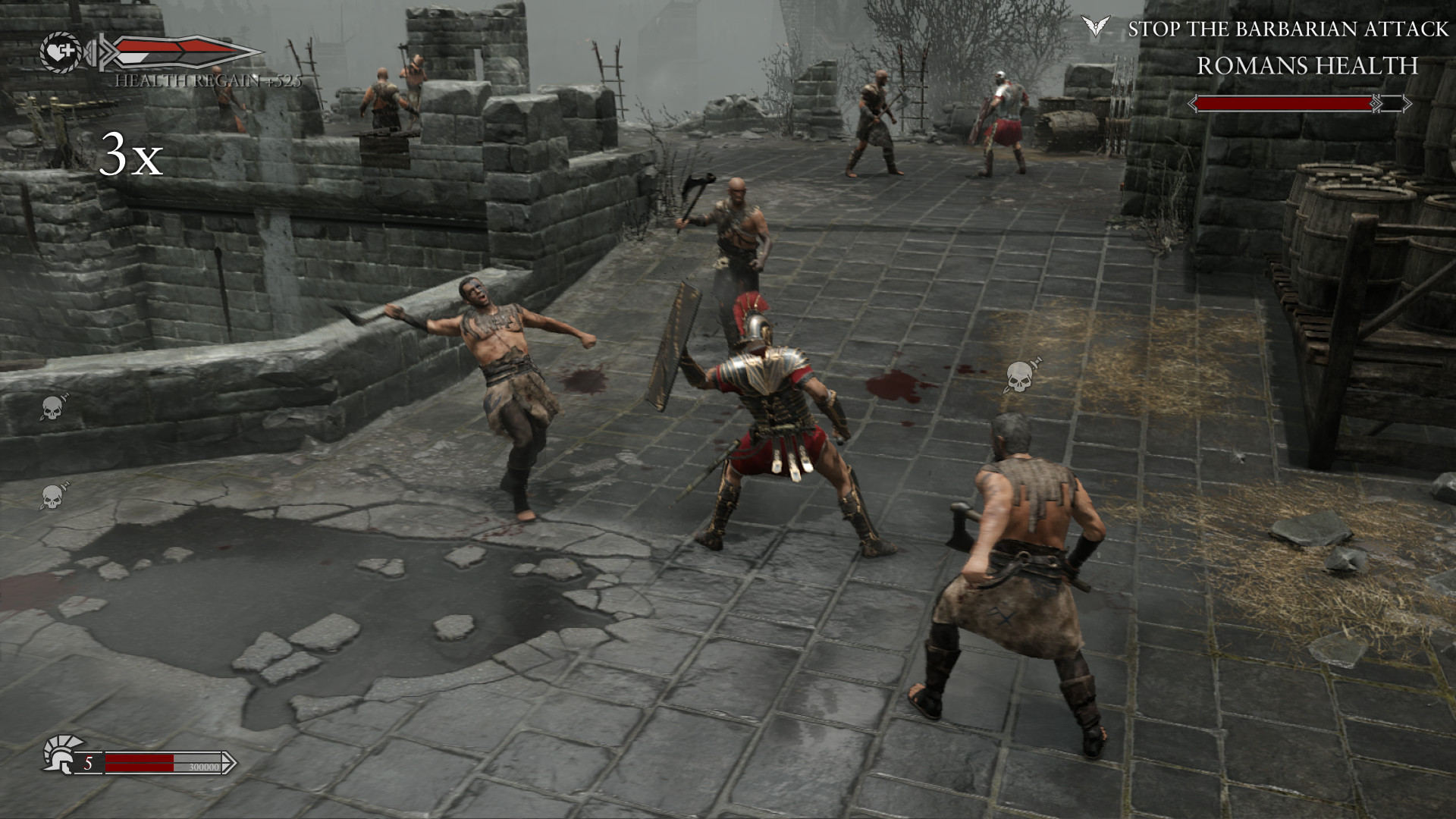
The above may seem like a big info-dump about a game’s combat system, but Ryse is its combat system. It is a continuous brawl through one strikingly-rendered place after another, told in flashback as Marius explains to the Roman emperor Nero just who he has been and who, through so much bloodshed, he has become. The story in the game is decent, if unsurprising. Family members are props who are there just to trigger obvious predictable moments. Our hero is the rightest man around in a world of moral monsters. Rome is burning. A Son of Rome must rise. You can figure it out and you can safely assume some echoes from Gladiator and 300.
The Batman Arkham games are also defined by their own wonderful combat system, but they have Batman lore and a lot of exploration to hook people who are bored of video game punching and kicking. Assassin’s Creeds have their building climbing, never-ending conspiracies and, recently, naval battles. Ryse has less. Just the combat, the graphics and the historical setting, though those simple elements do cohere well. As I played, I was repeatedly reminded of the similarly spartan first Assassin’s Creed. That game proved to be a great blueprint for a richer sequel, but in its time also served as a nice short trip to another era with some basic, solid and somewhat unconventional gameplay. Ryse is like that and gorgeous, too. From old cities to forests and bogs and seaside towns, the game regularly looks amazing.
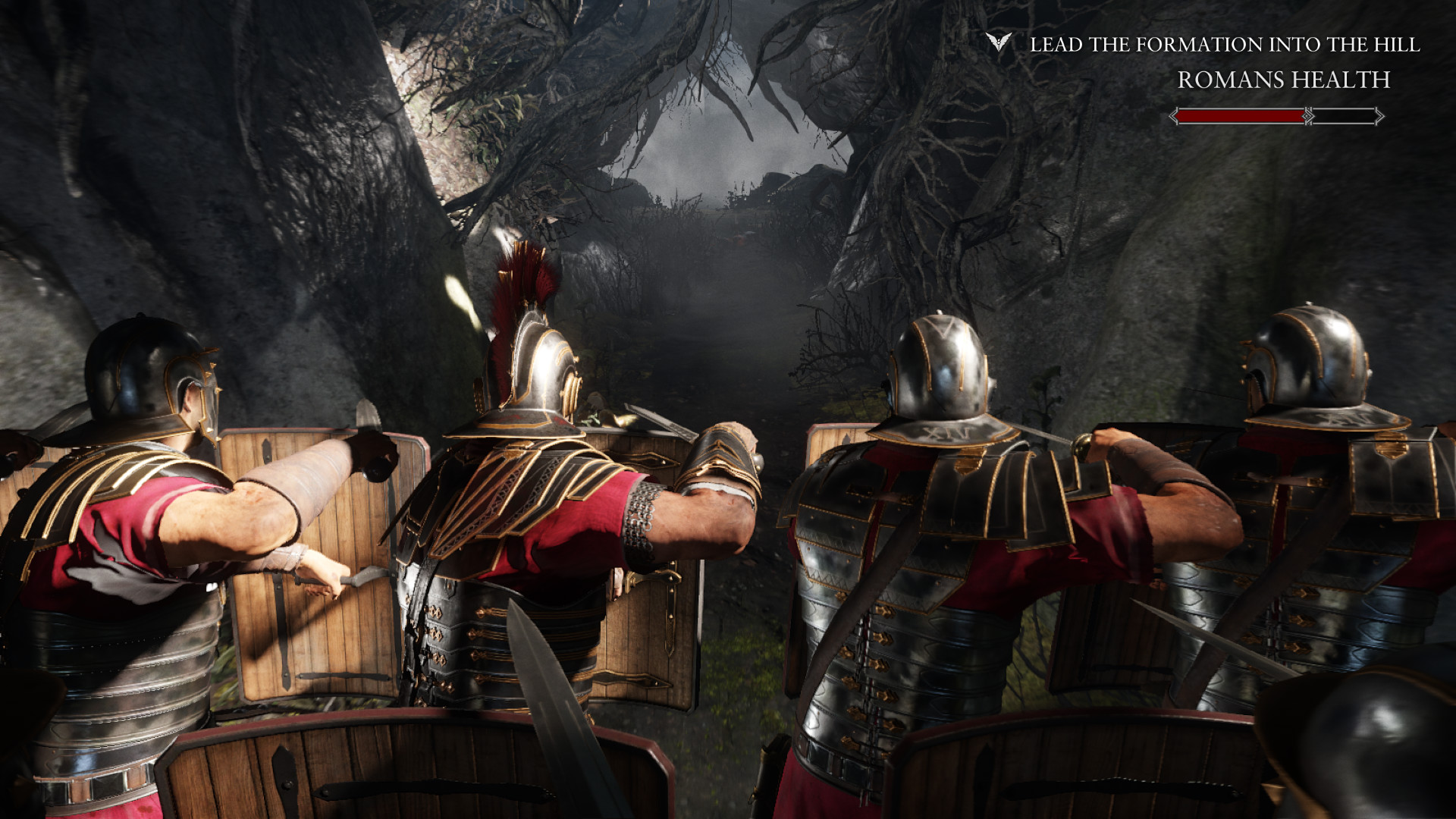
Sometimes Ryse doesn’t play the way I’ve described it. Sometimes Crytek makes Marius man an arrow-shooting turret. Sometimes Marius needs to throw spears instead of swing a sword. And sometimes, in the game’s dopiest moments, you need to yell at the Xbox One’s Kinect to tell your fellow Roman soldiers to fire volleys of arrows and protect Marius. All of that passes briefly and at least cleanses the palette.
I prefer the rare moments when you can hunker down with your fellow Roman legionnaires and march a phalanx toward an enemy emplacement. In these moments, the camera is tighter still, though this time the game developers really are just showing off. You’re usually marching toward enemy archers and the idea is to either advance as a unit or hunker down with shields held overhead. You should do the latter when a storm of arrows is incoming. Hunkering down looks cool, and each arrow that stabs its way into one of your men’s shields sends a sting of vibration through the Xbox One controller. Then you un-hunker, command your men to march or rear back and have everyone throw a spear of their own. The projectiles fly. You march. It’s a cool moment.
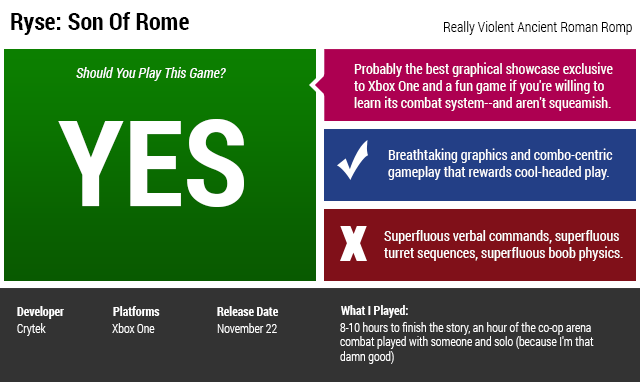
Ryse goes by fairly quickly. It’s maybe 10 hours long in normal difficulty. Toward its end, it begins to feel like that first Assassin’s Creed: more foundation or blueprint for a great new game, more proof of a slightly different concept. It also feels, in its eighth and final chapter, like the Kinect game it once was. The action is more on rails in that chapter. There’s less choice. It feels like a different game. Mostly, though, the game feels tight and trim. It moves from place to place quickly, doesn’t linger on any one moment too long, doesn’t waste player’s time with dull fights or padded battles.
I do wonder about the game’s one excess, though. It can be uncomfortably gory. The game certainly conveys that ancient war was brutal, but it also fetishises vicious executions with its close-up graphics. It’s hard to see how Ryse‘s combo system would work as well without the violent punctation depicted by the executions, but it’d be dishonest for me to say it left me unbothered. Seeing the whites of their eyes is one thing. Seeing the whites of their bones is something else.
Let’s think happier thoughts like… friendship! Camaraderie! The, um, opportunity for co-op executions of computer-controlled brutes! Ryse includes a multiplayer suite that can be played co-op or, oddly, solo. You fight in the Roman Coliseum using a modified version of the game’s combat system. Your nameless multiplayer gladiator starts out nearly naked but can unlock much better gear. You don’t exactly earn it. You earn gold, mostly by keeping the Roman crowd entertained, and then you can spend that gold on random packs that might contain boosts and upgrades. Mass Effect 3‘s multiplayer used a similar system, and, as with Mass Effect 3, you can pay real money to get gold for buying those packs. A simple level progression does prohibit profligate players from splurging on the best packs on day one. I liked what I tried of multiplayer but will withhold further comment about it until I play more post-launch. I’ll update this review when I do.
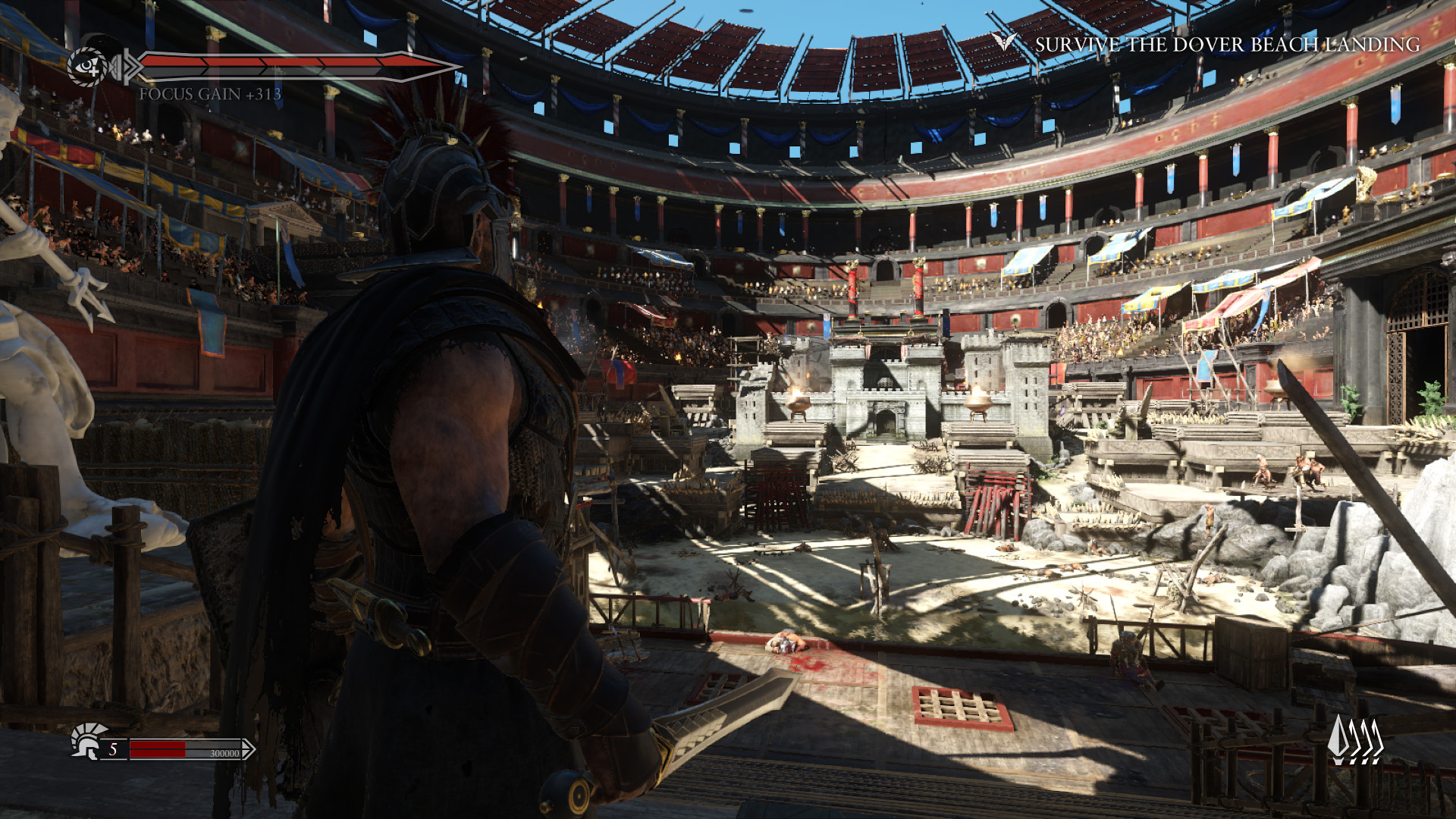
I’m not sure if seven years of development ensures we’ll get a sequel to Ryse to make the effort worth it or if it guarantees that the developers will never try this again. I’d be fine either way. Ryse‘s setting, graphics and novel combat system could serve as the blueprint for a more spectacular and more complicated game. Or Ryse could stand on its own as what it is: an interesting, weirdly violent yet somehow also attractive detour.
I’d like to think that Ryse is an example of the kind of fresh re-thinking we’ll experience on the new generation of consoles. Why not move the camera in? Why not set the game in ancient Rome? Why not let players yell at archers to lob in some support? Actually, no, never do that last one again. Ryse arrives with low expectations and demonstrates that looks can make a difference in gameplay. That’s a next-gen upgrade I can enjoy.
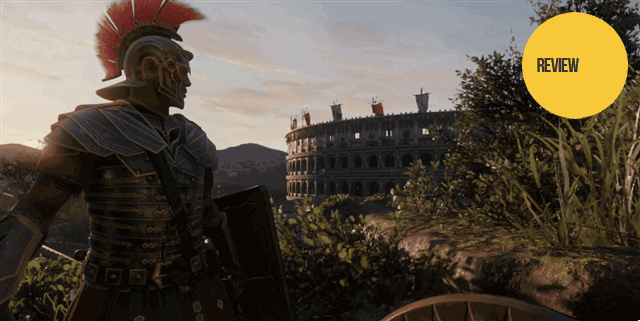
Comments
14 responses to “Ryse: Son Of Rome: The Kotaku Review”
What’s this? A balanced review of Ryse? Heresy!!!!!!! Nero will see you burn for this!
Am I missing part of the review? Boob physics? Turret sequences?
It’s a good tech demo
Why does all the screenshots showing such clear texture and mine looks so blurred.
Mine looks like it is trying to run a 900p on 1080p without upscaling on a 1080p TV
Seriously – Stop. With. The. Gifs.
I think you need to fight fire with fire to get the message through :/
Adblock these two lines (leave the rest though – ads help pay for the site):
http://img.gawkerassets.com/img/*/*.gif
http://edge.alluremedia.com.au/*/*/*/*/*.gif
That’s very helpful – thank you!
Anytime I see a gif i cant help but think i’ve time travelled back to the 90s.
Great review. Thanks Stephen.
It looks good and plays well – feels like a great rental. Is it worth replaying?
‘Combo-centric gameplay that rewards cool-headed play’ – Really?
I believe the phrase you’re looking for is – ‘so ezmode that we removed any incentive to play the game well’. See every other review for further proof. http://www.metacritic.com/game/xbox-one/ryse-son-of-rome
I returned my copy to Big W in three hours. Although it’s my own fault, I should’ve known from previews.
Ryse is installed and ready to lop extremities from well rendered barbarians as soon as the kids go to bed.
For all of the negatives I enjoyed reading a more positive review. Simply because even though I’m not expecting greatness, there was a moment during the pre-release demo I played that convinced me I might enjoy some mindless hack and slash in the Ryse world.
I guess I’ll find out very shortly, but when all is said and done, even if it only lasts the 8 odd hours through the campaign for me I’d much rather that then sit here and wonder if it were worth the time.
See for yourself I say.
Ryse has just become available this month as a games with gold freebie, so I thought I’d take a look.
It’s been 3 1/2 years since this review was written and still I couldn’t agree more with Stephen!
Yes, this game is VERY linear.
Yes, this game feels more like I am being swept along in a visually beautiful movie rather than a game.
Yes, when I do actually control Marius the combat is extremely repetitive… rinse & repeat.
Yes, once you’ve seen the 3-4 different enemies you’ve seen them all.
Yes, the story is predictable and somewhat corny.
But you know what, I really really enjoyed it! Being a father of 2 children under 5 years that only has 4-5 hours of Xbox time a week, I’ve come to really appreciate these sorts of games, rather than a sprawling 100+ plus sandbox (I’m looking at you Witcher 3).
Watching Marius’ animations in the execution sequences to try and preempt the cues and pull of Legendary executions and massive streaks never got tiring.